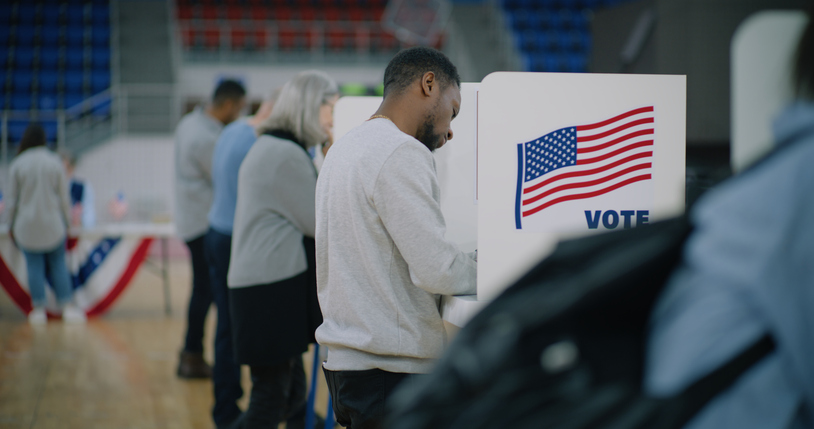
Although education policy has not been at the top of the political agenda in the run-up to the presidential election, the two candidates propose very different plans for the US education system, the consequences of which may be fundamental to the experience of being American.
Constitutionally, education policy is under the remit of state governments, so the argument has been made that the existence of the Department of Education is an overreach of federal control. Indeed, former president Donald Trump has pledged to eliminate the department, saying at a recent rally, “We will drain the government education swamp and stop the abuse of your taxpayer dollars to indoctrinate America’s youth with all sorts of things that you don’t want to have our youth hearing.”
However, the Department of Education does not exist to lay down educational policy or curricula—it’s there to help the educational system be more equitable. Access to a well-funded, quality education is a civil rights issue, and civil rights are very much the responsibility of the federal government.
Federal education funding through the department accounts for about 11% of education spending nationwide, the majority of which ($34 billion) is spent bolstering schools in low-income communities through Title I and helping students with disabilities through the Individuals with Disabilities Education Act (IDEA). The Trump campaign has not specified what it proposes to do with these programs, but Project 2025, the conservative policy agenda informally connected to Trump, proposes sending the funds for Title I and IDEA to states to spend as they choose, while phasing out federal spending on Title I over a ten-year period.
Reallocating Title I funding would decimate school districts in higher poverty areas, including most districts with high percentages of multilingual learners and minorities. The reality is that state and local governments have not been able, nor in some cases willing, to adequately fund schools in less affluent communities.
Vice President Kamala Harris has voiced support for programs to address inequity across early childhood, K–12, and higher education. She opposes plans to close the Department of Education and has proposed asking Congress to triple Title I funding and to fully fund IDEA. On the campaign trail, she has not focused on education but has suggested affordability measures for early childhood and higher education, including promising to continue the push for universal preschool, which has stalled in Congress.
Many members of the Republican Party, including Trump, claim that encouraging states to promote “school choice” through the provision of vouchers and Education Savings Accounts (ESAs)—giving parents public money for private school tuition—will help minority students receive the education they need to succeed. However, these programs reduce public school budgets and have not been shown to improve student levels of attainment. Recent large-scale voucher programs in Indiana and Louisiana have even been shown to result in negative effects on achievement.
Despite there being little proof of their efficacy, many states have enacted school choice programs—19 school choice bills were passed in 17 states in 2023, and 17 such bills have been approved so far in 2024. So, it seems they’re not in need of federal encouragement.
What the federal government does need to do is close the widening wealth gap and offer all Americans the opportunity of middle-class comfort. For decades, public schools have proven their capacity to encourage equity and provide opportunity for all. Universal public education was probably the most important reason the US became the richest country in the world in the 20th century1. Now, more than ever, we need to close the divides in our society by channeling funding to the schools that need it most, so that all students can share in the American Dream.
-Daniel Ward
Note
(i) “The U.S. advantage in the schooling of its young produced, by mid-century [20th], large differences between the educational stock of its labor force and that of other rich countries, a result that would hardly be surprising except for the fact that the United States had absorbed millions of less-educated immigrants. Only in recent decades have many rich countries caught up to, and even exceeded, the United States in years of education for young persons.
“At the same time that the United States led the world in mass education in the twentieth century, it rapidly expanded its economic lead. No single factor can account for the economic dominance of the United States in the twentieth century and most of the favored explanations, be they rooted in technological, institutional, or natural resource factors, are complementary ones. But despite that admonition, it would appear logical that part, possibly a major part, of the economic precedence of the United States came from its enormous lead in education.“
Goldin, Claudia and Lawrence F. Katz. 2001. “The Legacy of U.S. Educational Leadership: Notes on Distribution and Economic Growth in the 20th Century.” American Economic Review, 91 (2): 18–23.
Claudia Goldin, 2023 Nobel Prize winner in economics, also wrote:
“At the dawn of the twentieth century the industrial giants watched each other cautiously. The British sent high-ranking commissions to the United States and the United States sent similar groups to Britain and Germany. All were looking over their shoulders to see what made for economic greatness and what would ensure supremacy in the future… Earlier delegations focused on technology and physical capital. Those of the turn-of-the-century turned their attention to something different. People and training, not capital and technology, had become the new concerns…For the twentieth century to become the human capital century required vast changes in educational institutions, a commitment by governments to fund education, a readiness by taxpayers to pay for the education of other people’s children, a belief by business and industry that formal schooling mattered to them, and a willingness on the part of parents to send their children to school (and by youths to go). The transition occurred first in the United States and was accompanied by a set of “virtues” or principles, many of which can be summarized by the word “egalitarianism.”
See Goldin C, Katz LF. Why the United States Led in Education: Lessons from Secondary School Expansion, 1910 to 1940. In: Eltis D, Lewis F, Sokoloff K Human Capital and Institutions: A Long-Run View. Cambridge University Press ; 2009.





